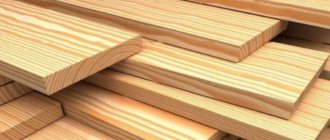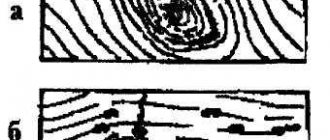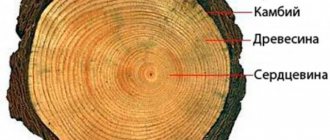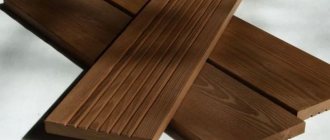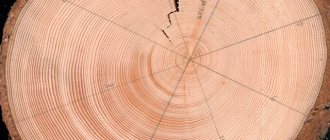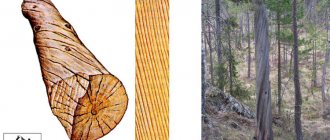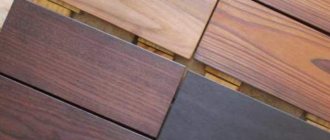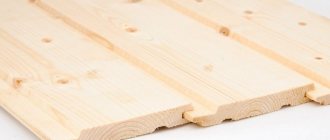Determination of strength and types of loads
One of the important mechanical properties of wood is its resistance to destructive mechanical influences, that is, strength. It depends on various factors, the most important of which are:
- Density;
- Humidity;
- Presence of defects;
- Wood species;
- The presence of destructive loads in different directions (for example, across or along the fibers), then the same tree will have different strength.
The strength of wood is affected by the moisture content in the cell membranes - bound moisture. The higher the humidity, the lower the strength. However, this rule applies up to a humidity level of 30%, which is the limit of hygroscopicity. Once this limit is reached, the strength remains unchanged even with increasing amounts of moisture. When determining strength indicators, wood samples must have the same moisture content. The duration of the destructive load also greatly affects the strength index.
Loads are distinguished by strength, direction and time of impact. Static ones act with a constant force or with a gradual increase, while dynamic ones act for a very short time, only at the moment of contact with the surface of the tree. These loads are usually called destructive, since their action damages the structure of the wood. The extreme strength values at which wood is able to maintain its structure are called tensile strength. The unit of measurement for strength is Pa/cm2 or otherwise kgf per 1 sq. cm.
Strength is measured in all directions - longitudinal, radial and tangential. During testing, tensile and compressive forces are used, and they are also tested for bending and shearing. Below is a table of the mechanical properties of wood.
Compressive strength is of great importance in building structures such as supports and posts. It is measured in different directions.
Evaluation of the material based on the complex of its natural and performance qualities
- Price – 3. Located in the middle range between more expensive and cheaper types of wood.
- Practicality – 4. The only disadvantage of oak material is associated with the need for careful drying.
- Appearance – 5. When processed, oak can compete even with elite wood varieties.
- Ease of manufacture - 4. Oak lumber is widely used in carpentry, but its processing is partly difficult due to its high hardness.
- Labor intensity during use – 4. Oak has a fairly high density, so transporting oak structural elements can cause difficulties.
- Environmental friendliness – 5. A small amount of resins helps maintain a “healthy” atmosphere in the room.
Untreated oak is sometimes called “boring” wood because it doesn’t stand out much among the variety of other wood materials. Minimal processing of an oak surface can radically change its appearance and place the product in the elite range. Strength, durability and ability to transform are the main properties of oak, for which it has been valued throughout human activity.
Testing the mechanical properties of wood in compression
Compressive strength is checked in the longitudinal and transverse directions relative to the fibers. In this case, during longitudinal compression, the length of the sample decreases. When testing a sample of soft wood with high humidity, the ends begin to wrinkle, and the side parts stick out to the side. Wood that is hard and dry under longitudinal compression begins to collapse and parts of the sample move in different directions.
The average value of the longitudinal compressive strength for all types of wood is about 500 kgf per 1 sq. cm.
The strength value during transverse compression is much less than during longitudinal compression and their ratio to each other is 1:8. The moment at which the destruction of wood during transverse compression occurs is not easy to determine, as is the pressure force at which it occurs.
Typically, lateral compressive strength is tested in two directions - radial and tangential. At the same time, hardwood has a strength 1.5 times greater when compressed in the radial direction than when compressed tangentially. The strength of coniferous wood under radial compression is lower than under tangential compression.
Testing the mechanical properties of wood for compression: a - along the grain; b - across the fibers - radially; c - across the fibers - tangentially.
Compound
When studying the issue of wood, it is imperative to familiarize yourself with its composition. It contains organic substances, which include:
· nitrogen;
· hydrogen;
· carbon;
· oxygen.
The elemental chemical composition of different breeds remains almost the same. Absolutely dry material will contain 49.5% carbon, 6.3% hydrogen and 44.2% oxygen with nitrogen. The latter is contained in the material in a volume of 0.12%. The elementary chemical composition of wood in the area of branches and trunk is almost the same. Growing conditions also do not in any way affect the content of basic elements.
In addition to organic substances, wood contains mineral compounds that produce ash when burned. The amount of the mentioned element reaches 1.7%. In some breeds, the volume of ash may be higher and amount to 3.5%. For the same species, the amount of ash will depend on the part of the tree, growing conditions and age, as well as position in the trunk.
More ash is obtained by burning leaves and bark, and oak stem wood provides approximately 0.35%. The wood of the branches contains more ash than the wood of the trunk. The ash contains salts of alkaline earth metals. If we are talking about pine wood, then the ash, as well as the ash of birch and spruce, contains calcium salts in a volume of 40%.
The chemical composition of early and late wood is almost the same, this refers to the content of hemicellulose, lignin and cellulose. Early wood contains more substances that dissolve in ether and water. This is especially true of larch.
The chemical composition changes little along the height of the trunk. No almost noticeable differences in height were found in the oak composition. A slight increase in cellulose content was found in aspen, spruce and pine at the age of ripeness.
Wood tensile strength
The tensile strength of wood along the fibers ranges from 1100 to 1400 kgf/cm2, although its use in tensile parts is difficult due to the fact that it cannot withstand loads at fastening points. In these places, compression and shearing forces act on the wood, and they have lower values. A striking example of the use of wood with tensile work are shafts in horse-drawn carriages.
In the transverse direction, the tensile strength is low and its value does not exceed 5% of the tensile strength in the longitudinal direction. Therefore, in cases where a wooden part works in tension, only wood with a longitudinal arrangement of fibers is used.
The value of the transverse tensile strength of wood is taken into account when cutting and drying the material; the modes of these operations are selected in direct proportion to the strength.
Recycling
Wood processing can be carried out in one of several ways, including:
· chemical-mechanical;
· mechanical;
· chemical.
Mechanical processing technology involves changing the shape by planing, sawing, peeling, milling, turning, drilling, splitting, carving and grinding. With mechanical processing, it is possible to obtain consumer and industrial goods.
Wood can be subjected to mechanical abrasion, which makes it possible to obtain fibrous semi-finished products. Wood processing can be carried out using chemical-mechanical technology. This makes it possible to obtain an intermediate product from a material that is uniform in size and composition. The surface is coated with a binder.
Under the influence of pressure and temperature, a polymerization reaction of the binder occurs, as a result of which the intermediate wood product sticks together. With this processing we get:
· cement particle boards;
· wood-based materials;
· carpentry;
· fiberboard;
· wood concrete.
Chemical processing is carried out by the method of thermal decomposition and exposure to: solvents, acids, alkalis, acid salts, sulfurous acid. This technology is called pyrolysis or thermal decomposition. The raw materials are heated at high temperatures without access to oxygen. This allows you to obtain products in different states, including:
· gaseous;
· liquid;
· hard.
Of these, charcoal has the greatest practical importance.
Testing the mechanical properties of wood for bending
The average bending strength of all tree species is considered to be 1000 kgf/cm2, which is twice the compressive strength and approximately 30% less than the longitudinal tensile strength. When bending, different layers of wood experience different stresses - the top layer receives compression, and the bottom, on the contrary, experiences tension. In the middle part of the sample subjected to bending there is a neutral region that does not experience any stress. The area experiencing tensile stress begins to collapse first - the outermost fibers of the wood break.
You can visually determine the bending strength of wood by the nature of the fracture - high-quality samples will have an uneven fracture with the presence of a large amount of chips, and a defective one will have an almost even fracture, without protrusions and dents.
When bending, one part of the workpiece is subjected to compression, the other to tension, so the bending resistance indicator is between the compression and tension resistance indicators. The ratio of compressive strength to tensile strength varies from 1.7 to 2.2 for different types of wood.
The humidity of the wood is also reflected in the resistance to static bending - when the humidity changes by 1%, the resistance changes by 4%.
The strength or fragility of wood can be determined by the resistance to impact bending. If the resistance is low, the wood is brittle, and a high resistance value indicates high viscosity of the wood.
Impact bending resistance is measured using a pendulum by measuring the work Q kg/m required by a pendulum of a certain weight to break the test block. The resistance itself is calculated using the formula A = Q/bh2, in which b and h are the width and height of the cross-section of the sample in centimeters, respectively.
Testing the mechanical properties of wood for bending
The use of wood as a structural material is due to its ability to resist forces, i.e. mechanical properties.
The following properties of wood , manifested under the influence of mechanical loads: strength - the ability to resist destruction, deformability - the ability to resist changes in size and shape, technological and operational properties.
Indicators of the mechanical properties of wood are usually determined using the following types of tests: tension, compression, bending and shear. Since wood is an anisotropic material, i.e. material with different properties in different directions, indicate the direction of load action: along or across the fibers (in the radial or tangential direction).
Due to the resistance of wood to external loads, internal forces arise in it. These forces per unit cross-sectional area (1 cm2) are called stresses. The maximum stress preceding the destruction of a body is called the tensile strength.
Wood strength
The tensile strength is determined on small, clean and defect-free samples in laboratories using testing machines. These samples have a base section with dimensions of 20 * 20 mm and must include at least 4-5 annual layers. Some types of tests are performed on samples whose cross-section differs from the specified one.
strength of wood is determined using prismatic samples. The design of the compressive strength test along the fibers and the size of the sample are shown in the figure:
The sample is gradually loaded until failure. Then, the maximum load Pmax, N, is calculated using the force meter of the testing machine. The tensile strength b, MPa, is calculated using the formula: bw = Pmax / (a * b), where (a * b) is the cross-sectional area of the sample, mm2.
On average, for all domestic species at a wood moisture content of 12%, the compressive strength of wood along the grain is about 50 MPa.
The compressive strength across the fibers is determined according to the diagram in the figure. Here the resultant of forces is indicated, which are either uniformly distributed over the entire surface of the sample, or across the entire width, but over part of its length (local compression). In both cases, the conditional tensile strength is determined. The limit of proportionality is used as this indicator, i.e. the magnitude of stresses up to which a linear relationship between stresses and strains is observed. On average, for all tree species it is 1/10 of the compressive strength along the grain.
Tests for the tensile strength of wood are carried out on samples of another type:
This form of the samples is due to the desire to ensure destruction in the thin working part, and not at the place of fastening, under the influence of tensile stresses.
On average, for all rocks, the tensile strength along the fibers is 130 MPa, and the tensile strength across the fibers is 20 times lower. Therefore, when designing wood products, tensile loads directed across the fibers are avoided.
To test wood for static bending, bar-shaped samples with dimensions of 20 * 20 * 300 mm are used:
Ultimate strength during static bending, MPa, is calculated using the formula: bw = (3/2) * ((Pmax*l) / (b * h2)), where Pmax is the maximum load, N; l - span, i.e. distance between centers of supports equal to 240 mm; b and h—width (in radial) and height (in tangential) directions, mm.
On average, the tensile strength during static bending is 100 MPa.
During testing, two equal and oppositely directed forces are applied to the sample, causing destruction in a plane parallel to them, and shear occurs. There are three types of shear tests: shearing along the grain, shearing across the grain and cutting wood across the grain. The diagrams of force action during these tests are shown in the figure:
To test for shearing along the grain, a sample is used, the shape and dimensions of which are shown in the figure:
The tensile strength when shearing along the fibers is determined by the formula: Tw = Pmax / (b * l), where (b * l) is the shearing area, mm2.
The value of the ultimate strength—maximum tangential stresses during shearing along the grain—on average for all rocks is approximately 1/5 of the ultimate compressive strength along the grain. The tensile strength when shearing across the grain is 2 times less, and the tensile strength when cutting across the grain is 4 times greater than the tensile strength when shearing along the grain.
Deformability of wood
Under short-term loads, predominantly elastic deformations occur in wood, which disappear after the load. Up to a certain limit, the relationship between stress and strain is close to linear (Hooke's law). The main indicator of deformability is the coefficient of proportionality - the elastic modulus.
The elastic modulus along the fibers is E = 12-16 GPa, which is 20 times greater than across the fibers. The higher the elastic modulus, the stiffer the wood.
With an increase in the content of bound water and the temperature of the wood, its hardness decreases. In loaded wood, when drying or cooling, part of the elastic deformations is converted into “frozen” residual deformations. They disappear when heated or moistened.
Since wood consists mainly of polymers with long, flexible chain molecules, its deformability depends on the duration of exposure to loads. The mechanical properties of wood, like other polymers, are studied on the basis of the general science of rheology. This science examines the general laws of deformation of materials under the influence of load, taking into account the time factor.
Operational and technological properties of wood
The strength of wood under long-term constant loads is important to know in connection with its use in building structures. An indicator of this property is the limit of long-term resistance of the bd.s., which on average for all types of load is approximately 0.5 - 0.6 of the tensile strength during short-term static tests.
An indicator of wood strength under variable loads is the endurance limit, the average value of which is approximately 0.2 of the static strength limit.
When designing wooden structures, calculations do not use the strength limits of small wood samples, but several times smaller indicators - calculated resistances. They take into account the large size of structural elements, the presence of wood defects, the duration of the load, humidity, temperature and other factors.
Specific viscosity characterizes the ability of wood to absorb work upon impact without destruction and is determined during bending tests. The impact strength of hardwood wood is on average 2 times greater than that of softwood wood.
Hardness characterizes the ability of wood to resist the indentation of a harder body. Static hardness tests are carried out according to the scheme shown in the figure:
To test hardness, use a device that has a punch with a hemispherical tip. It is pressed to the depth of the radius. After the test, an imprint remains in the wood, the projection area of which at the specified radius of the hemisphere is 100 mm2. An indicator of the static hardness of a sample, N/mm2, is the force per this area. The static hardness of the end surface is higher than that of the side surfaces.
All domestic species of trees and shrubs are divided into 3 groups based on the hardness of the end surface at a humidity of 12%: soft (hardness 40 N/mm2 or less), hard (41-80) and very hard (more than 80 N/mm2).
Impact hardness is determined by dropping a steel ball with a diameter of 25 mm from a height of 0.5 m onto the surface of a sample, the greater the value of which, the lower the hardness of the wood.
Wear resistance is the ability of wood to resist wear, i.e. gradual destruction of its surface zones during friction. Tests on the wear resistance of wood have shown that wear from the side surfaces is significantly greater than from the end cut surface. As the density and hardness of the wood increased, wear decreased. Wet wood wears more than dry wood.
A unique property of wood is its ability to hold fasteners: nails, screws, staples, crutches, etc. When driving a nail into wood, elastic deformations occur, which provide sufficient friction force to prevent the nail from being pulled out. The force required to pull out a nail driven into the end of the sample is less than the force applied to a nail driven across the fibers. As the density of wood increases, the resistance of wood to pulling out a nail or screw increases. The effort required to pull out screws (other things being equal) is greater than for pulling out nails, since in this case the resistance of the fibers to cutting and tearing is added to friction.
The technological operation of bending wood is based on its ability to deform relatively easily under the action of avoiding forces. The ability to bend is higher in ring-vascular species - oak , ash, etc., and among scattered-vascular species - beech; Coniferous trees have less bending ability. Wood that is in a heated and wet state is subjected to bending. This increases the flexibility of the wood and allows, due to the formation of frozen deformations during subsequent cooling and drying under load, a new shape of the part to be fixed.
For a comparative assessment of the quality of wood, the so-called specific characteristics of mechanical properties are used, i.e. indicators of its mechanical properties, referred to a unit of density.
The specific compressive and static bending strength of coniferous trees is higher than that of deciduous trees. The specific hardness of conifers is also significantly higher. For other properties, the specific characteristics of deciduous wood are higher than those of coniferous wood.
The specific characteristics of wood are of particular importance when a product or structure requires high strength with low weight. This is important for transport engineering, aircraft manufacturing, shipbuilding and in other cases.
https://www.wood.ru/ru/lpsmeh.html
Shear strength of wood
The displacement in the workpiece of one part of the wood relative to another is called shear. Shears are formed under the influence of external loads of various types. There are shifts that arise from chipping along or across the fibers and from sawing (cutting).
The shear strength is approximately 5 times less than the longitudinal compressive strength. And if we compare the shear strength along and across the fibers in one sample, then the tensile strength for longitudinal shearing is two times higher than for transverse shearing. The strength of wood when cutting is four times higher than the strength when chopping.
Use in pulp and paper production
If you are interested in the question of what is made from wood, then you can take a closer look at pulp and paper production. It involves the production of cardboard and paper using semi-finished fibrous products. They are represented by cellulose and wood pulp.
Approximately 93% of cellulose is used for the needs of such production. The rest serves as raw material for chemical processing into acetate or artificial viscose fiber, smokeless powder, plastic, film, cellophane and other products.
Area of use of light wood
The lightest wood is balsa. It belongs to the mallow family and is native to South America. From these raw materials the Norwegian explorer's raft was built, on which he made his way across the Pacific Ocean. Ultra-light wood is used in the aviation industry as a material for sound and thermal insulation.
Balsa is used in shipbuilding and ship modeling. The raw materials form the basis of surfboards. Used to make:
· layouts;
· scenery;
· water rescue equipment;
· floats.
The lightness is due to the speed of growth. By the age of five, the tree becomes mature. Large plants have strong and light wood, which is considered the lightest when dried. When freshly cut, the wood is heavy, as it contains up to 95% water. The material dries quickly and becomes dense, quite strong and light. When compared with the popular pine, balsa structures are stronger, stiffer and lighter.
Balsa is easy to process, but requires a special tool with a small pointed angle and a thin blade. Wood parts are poorly suited to painting, which is especially true for paints and varnishes. It is possible to use a water-based mixture or compositions in the form of alcohol mordants.
Description of the main varieties of conifers and their application
Coniferous wood includes cedar, which is a highly ornamental crop. It is used in landscape design, and the characteristics of this lumber make the tree the most popular in construction. Cedar is a natural antiseptic, so a house built from this raw material will be free of bacteria.
Larch is a deciduous coniferous tree, the most durable of the common coniferous timber products. The tensile strength is 105 N/mm2. Thanks to this, the raw material is popular in the production of floor boards, lining and decking boards. Ships have long been built from larch. It has a high resin content, it has an impressive strength, and therefore retains its original characteristics when exposed to humidity.
Pine is inferior to larch in strength - 100 N/mm2. But sometimes this becomes an advantage, because the material is easier to process. Pine is a universal raw material from which floorboards, imitation timber and eurolining are made.
The strength of spruce is lower and amounts to 80 N/mm2. But it is characterized by high plasticity, therefore it is common in the production of profiled timber. Pine and spruce have increased resin content, which plays a protective role. The wood is not exposed to moisture, bugs and fungi. This raw material is highly malleable and easy to process.
Pine and spruce lumber are selected for the manufacture of complex and small structures such as balconies and railings. The low density allows timber and boards to be impregnated with a composition to increase strength and durability. If you build a country house from spruce or pine, it will last up to 50 years. Whereas if you use cedar, the service life of the building will double.
piezoelectric wood modules
| Breed | Piezoelectric modules in 108 absolute electrostatic units by sample | |
| radial | tangential | |
| Pine | 0,392 | 0,578 |
| Spruce | 0,550 | 0,570 |
| Oak | 0,254 | 0,534 |
| Birch | 0,470 | 0,620 |
The discovery allows for a deeper study of the fine structure of wood. Indicators of the piezoelectric effect can serve as quantitative characteristics of cellulose orientation and are therefore very important for studying the anisotropy of natural wood and new wood materials with properties specified in certain directions.
specific volumetric resistivity of wood in a completely dry state
| Breed | Specific volume resistivity, ohm x cm | |
| across the grain | along the grain | |
| Pine | 2.3 x 1015 | 1.8 x 1015 |
| Spruce | 7.6 x 1016 | 3.8 x 1016 |
| Ash | 3.3 x 1016 | 3.8 x 1015 |
| Hornbeam | 8.0 x 1016 | 1.3 x 1015 |
| Maple | 6.6 x 1017 | 3.3 x 1017 |
| Birch | 5.1 x 1016 | 2.3 x 1016 |
| Alder | 1.0 x 1017 | 9.6 x 1015 |
| Linden | 1.5 x 1016 | 6.4 x 1015 |
| Aspen | 1.7 x 1016 | 8.0 x 1015 |

